Interview: Jude Turczynski of Huki Surfskis and Outrigger Canoes
If you come to the U.S. Surfski Championships in San Francisco you will see a lot of Huki surfskis. These popular northern California surfskis are the work of Jude Turczynski.
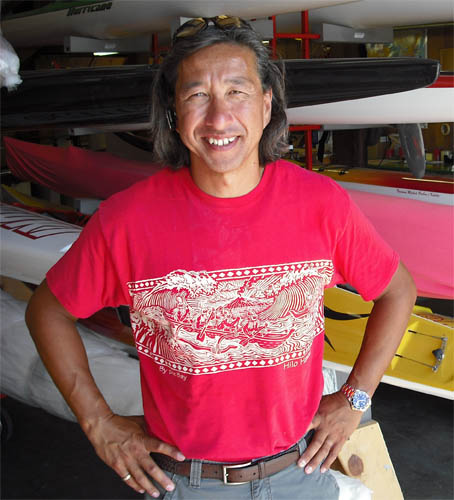
In addition to being known for custom color schemes and custom lay-up options, their craftsmanship and innovations are second to none. Paddling is Jude Turczynski's life. When not building surfskis and outrigger canoes or on the phone, Jude can be found racing and generously supporting the local racing scene. I talked to Jude in June about surfskis.
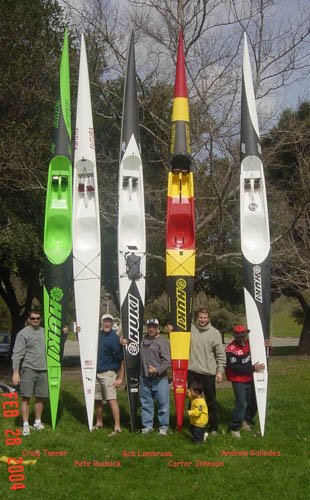
Background
Where did you grow up? Mainly in the Sacramento Valley of Northern California with time in Canada, Alaska, Oregon, and other places along the Pacific North West.
How old are you? 49
Inquiring minds want to know about your name. My father was Pennsylvania Dutch-Pollock and my Filipina mother had a penchant for Saint Jude.
What does ‘Huki' mean? Pull. It's the command that's shouted by the steers-people in the line up at the start of a race.
Tell me about your paddling background. I understand you have done Molokai a couple of times in an OC6. What kind of conditions did you have? Any harrowing tales? I started paddling OC6 in my late twenties and built my own one-man traditional canoe because there were only two brands on the market that I knew of and I couldn't afford either one of them even in fiberglass. I built my own traditional OC2 in 1990 with instruction from Jerry Montgomery, the master sailboat designer and builder. I raced these two boats to many championship wins. I've only crossed Molokai twice steering in the OC6. Conditions were nine to twelve foot seas with the entire canoe and everyone's head covered by the swell at once.
How often do you paddle now? Not enough.
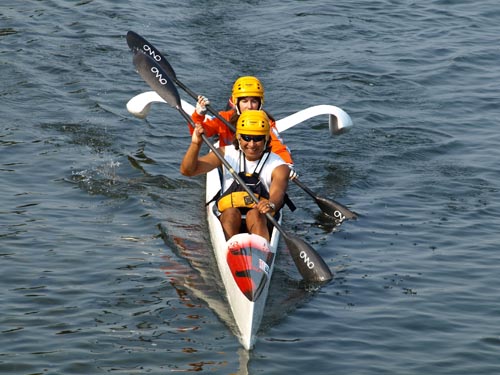
Boat building
How and when did you get started building outrigger canoes and surfskis? Building canoes for me became a business building canoes for other people. I got into surfskis and started building those too.
Are surfskis and outriggers pretty made the same way regardless of who the manufacturer is? Do some boats have stringers? There are more ways to build surfskis and canoes than I could even list and every company is using some variation and combination of the methods. Most surfskis and boats have stringers and each maker chooses their own stringer style.
What makes your outriggers and surfskis unique construction-wise? I offer a dozen different construction types and each one in turn offers an advantage in either price, weight, durability, or a combination thereof. The customer basically gets to determine which structure fits their needs.
What's the ratio of surfskis to outriggers that you produce? It's pretty much 50-50.
You are located in Sacramento, not on the coast of California, is that a problem, advantage, or not an issue?
Sacramento is only 40 minutes from the Bay and for a lot of commuters on the mainland I could be living 15 miles from the ocean with the same commute time. Customers come to Sacramento to demo my canoes and surfskis on the large rivers we have all the time. There's no issue.
Do you sell more surfskis in Northern California or Southern? I sell a lot more surfskis in Northern California than in Southern Cal but I've been working hard to improve SoCal sales.
Where else in the world are you selling surfskis? My sales are mostly throughout the North American continent and Hawaii with occasional sales in Europe, Asia, and so on.
Design
Your first surfski was the John Dixon designed S1-A that premiered in 2003. Can you tell me how that came about and what you learned from John and that experience? John wanted a surfski that really fit him well and I offered to build the first skis from his new mold at a reasonable price if he would allow me to manufacture and market the skis commercially. His hull design taught me and Jerry Montgommery that a nearly flat surfski hull could be a fast hull if you controlled issues, such as wetted surface area, prismatic co-efficient, beam, and rocker. We started to analyze design in a whole new way.
When you came out with the S1-X it was very popular, were you surprised? The market was ready for a stable surfski that would fit almost anyone. After many long conversations with Mike Shea and Dave Jensen about what surfskis of the day lacked and what they did well, Jerry and I came up with the S1-X. We gave her a round hull with a sudden turn in the sides below the waterline that made it look like a flat bottom. In addition, she got fairly consistent rocker from end to end, and a narrow catch zone. The S1-X caught on fast locally and discussion on newly formed email groups spread its reputation farther.
You've gone from a relatively thick rudder to a very thin one. What's the thinking on that? I'm just trying to make customers happy. Racers like a rudder that slices through the water when traveling straight ahead. A thick rudder on the other hand has a very efficient turn but most racers spend very little time turning.
You moved the rudder farther forward on the S1-X special to improve steering in surfing conditions. What happens if you move it even farther forward? As the rudder position moves farther forward along the waterline it loses leverage and the potential for YAW increases but these are rough water boats and the waterline spends a great deal of time farther forward than it does in flat water.
From time to time there is talk about surfskis suited to women and to light men. The S1-A seems to be that boat but a bit too tippy for most paddlers. Have you thought about a redesign for the ‘A'? No, I haven't but I have thought about another version of the S1-X.
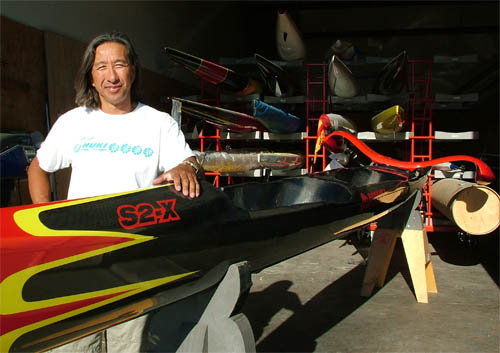
The Future
Where can surfski design go from here? What's ahead for Huki? As the number of surfski paddlers increases I imagine there will be a demand for more specialized surfskis. The paddlers will ultimately drive development, no matter what and Huki will be there to design what they want
Thanks for your time..
Thanks for giving me the opportunity to talk about paddling.
Steve Hansen is an avid paddler from the Sacramento area that wishes he got to the San Francisco Bay more often to paddle.
Gull-wing
[Editor: That gull-wing attachment in the photos that Steve sent us intrigued me - particularly as my friend Kathleen "HukiGirl" Petereit from British Colombia also sent me a couple of pics of herself in a gull-wing equipped S1-X...
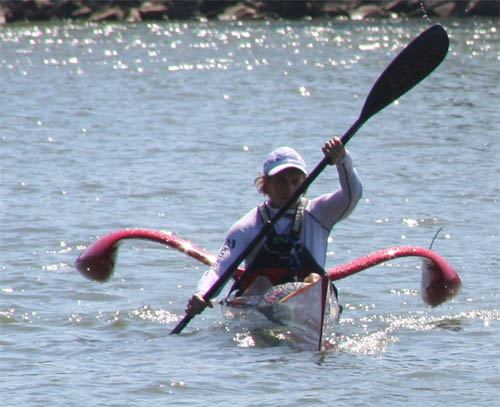
"I tried Huki's new Gullwing today," wrote HukiGirl. "This thing is freakin' amazing. I could not dump the ski, check out the pic.
"This will add a whole new safety dimension for those big water days and for winter paddling for us," she added.
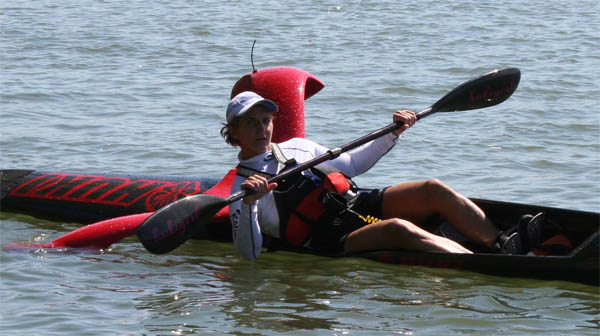
I wrote to Jude himself to ask about this innovative idea.
"The Gull Wing was inspired my fiance's need for a super stable surfski that was still super fast," he said. "I think it holds great promise for all paddlers who feel insecure in really big seas.
"The Gull Wing mounts to almost any surfski and kayak with internally retro fitted reinforcements to the deck and seams. All Huki surfskis are easily and quickly retro fitted, including our tandem ski.
"After initial installation, removing the Gull Wing takes only a minute by unscrewing four small thumb screws...NO TOOLS. You can paddle with or without it. The wing weighs 7 pounds and is pretty darn tough. A properly done retro it should have no more problems with breakage than outrigger canoes."
US$800 for a Gull Wing kit. Installation is US$200.
The Gull Wing is patent pending."]

